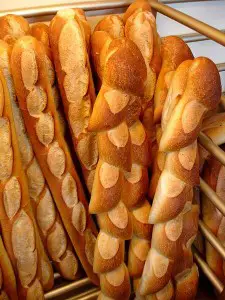
A baguette is a traditional French bread. It originated in France in the 1800s, gained popularity in the 1900s, and is now found in most parts of the world. A baguette is essentially sandwich bread. Its smell is divine, and it is a long loaf, crispy on the outside with a light, airy interior. Its diameter is around 2 inches and the length is approximately 26 inches (a little more than two feet). Even though a baguette is a French bread, it can be found outside of France because of its immense popularity in terms of flavor and texture.
The name baguette is derived from the Latin word balucum, which means a stick or wand. This name suits the bread, because it is long, resembling a wand. The ingredients required to bake a loaf of this bread are salt, water, yeast, and flour. Baking baguettes is an art: not everyone is accomplished enough to bake a true baguette. There are a number of baking competitions in France, where the person who bakes the perfect baguette bags the prize.
This kind of bread is best eaten when fresh,as it gets stale quickly and loses it crispy exterior. A short baguette is often termed a French stick in places outside France. Most submarine sandwiches are made from this bread. Countries outside France have their own take on the baguette; they tend to change the flour and the dough. Rice-flour, multi-grain, and whole wheat baguettes find a place on the shelves of grocery stores outside of France.
A baguette can be complimented with different types of food preparations like soups and salads. It is healthy because it does not contain fat. Today the baguette is a symbol of the French culture and defines their food heritage. French food has gained immense popularity all over the world, and the baguette is yet another example as to how French food has branched out all over the globe.










Leave a Reply